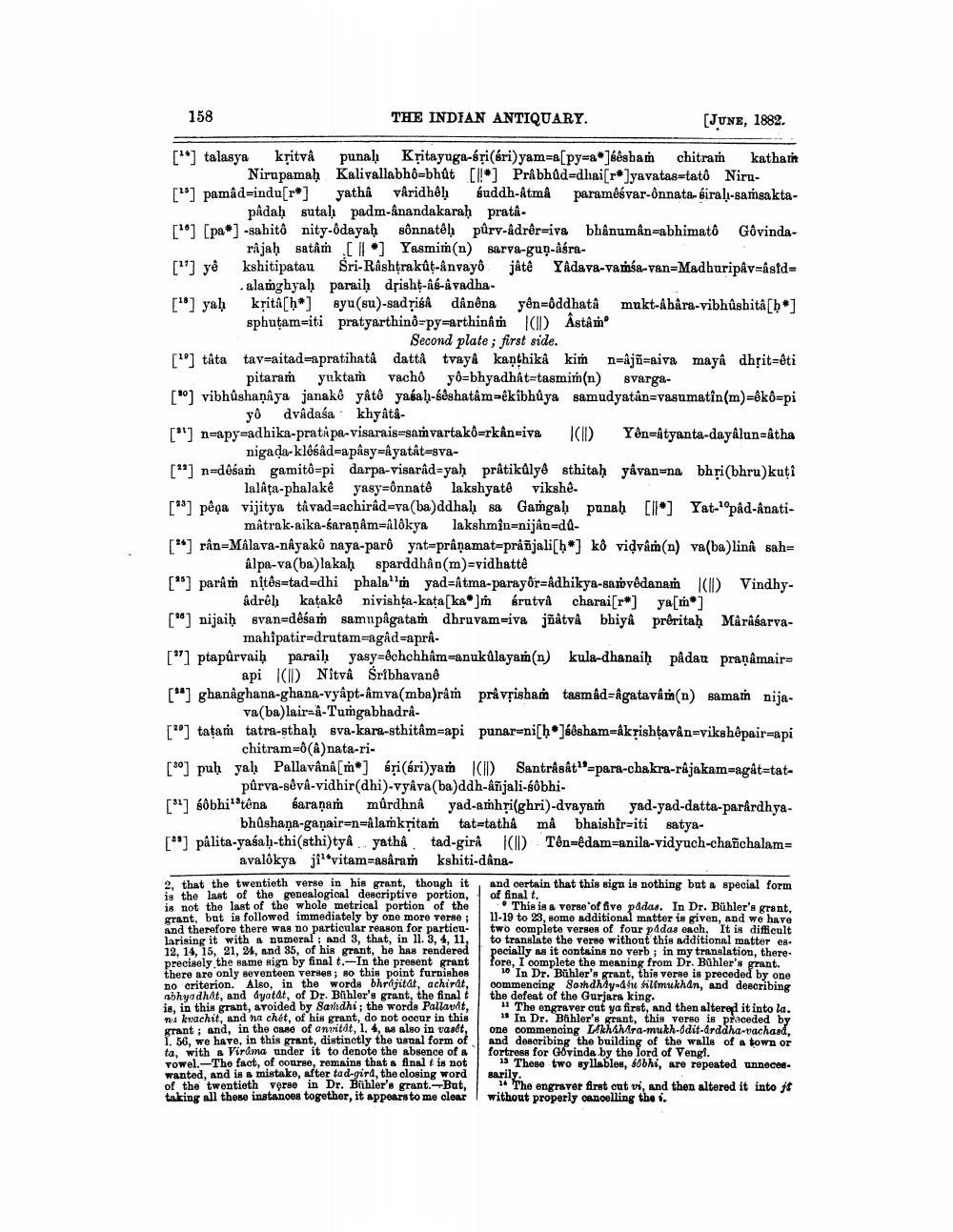________________
THE INDIAN ANTIQUARY.
[JUNE, 1882.
[**] talasya kritvá punah Kitayngs-éri(ári)yam-apy-ashash chitram katham Nirupamaḥ Kalivallabhô-bhût [*] Prabhûd-dhai[r*]yavatas-tatô Niru[] pamâd-indu[r] yatha vâridhêḥ śuddh-âtmå paramêśvar-ônnata- éiral-samsakta
158
padaḥ sutaḥ padm-ânandakaraḥ prata
[] [pa] -sahitô nity-ôdayah sônnatêl pûrv-âdrêr-iva bhânumân-abhimatô Govindarajaḥ satâm [*] Yasmim (n) sarva-gun-âśra
["] yê
kshitipatau Sri-Rashtrakut-ânvayô jâte Yadava-vamsa-van-Madhuripâv-âsid= alamghyal paraiḥ drisht-âé-âvadha
[1]yah kriti[h*] syu(su)-sadrisa dânêna
yên-ôddhatâ
sphatam-iti pratyarthind-py-arthindth ) Ast
mukt-âbâra-vibhûshitâ[b]
Second plate; first side.
[1] tâta tav=aitad-apratihatâ dattâ tvaya kanthika kim n=âjñ-aiva mayâ dhṛit-êti pitaram yuktam vacho yô-bhyadhât=tasmim(n) svarga[*] vibhushaniya janak yatê yasal-léshatim-ikibblys samadyatan-rasumatin(m)-ékb-pi yô dvidaśa khyit -
[]
n-apy-adhika-pentapa-visarais-savartakůrkiva
KID Yên-ityanta-day lun-tha
nigada-klôid-apisy-iyatât-eva
[2] n-dêsam gamitô-pi darpa-visarâd-yah prâtikulyê sthitaḥ yâvan-na bhri(bhru)kuți lalâța-phalakê yasy-ônnatê lakshyatê vikshê
[] påga vijitya tavad-achirid-va(ba)ddha sa Gagal punab [1] Yat-pad-inatimitrak-aika-daranam-lökya lakshmi-aijin-d4
[**]rin-Mälava-nyakú naya-parů yat-prāṇamat=práñjali[b] kô vidvů(n) va(ba)lin sah alpa-va(ba)lakab sparddhin(m)-vidhatte
[*] parâm nitês-tad-dhi phalam yad-atma-parayor-adhikya-samvêdanam (1) Vindhyâdreh katake nivishta-kata [ka]m śrutvå charai[r*] ya[m] [] nijaiḥ svan-dêsam samupâgatam dhruvam-iva jñâtvå bhiyâ prêritaḥ Mârâsarva
mahipatir-drutam-agâd=aprâ
["] ptapurvaiḥ paraih yasy-êchchhâm-anukûlayam (n) kula-dhanaiḥ pâdau pranâmair= api () Nitvå Śribhavanê
[] ghanaghana-ghana-vyâpt-âmva (mba)râm prâvrisham tasmâd-âgatavam (n) samam nijava(ba)lair-d-Tungabhadri
[] tatam tatra-sthab ava-kara-athitkm-api punar-ni[b*]álsham-Akṛishtavin=vikablpair-api
chitram ô(a)nata-ri
[] pub yah Pallavind[*] (ri)yah ) Santriais"-para-chakra-råjakam-agút=tatpûrva-sêva-vidhir(dhi)-vyâva (ba)ddh-âñjali-śôbhi
["] sôbhi1têna saraṇaṁ mûrdhna yad-amhri(ghri)-dvayam yad-yad-datta-parårdhyabhushana-ganair-n-âlamkṛitam tat-tatha må bhaishir=iti satya
[] pâlita-yaśaḥ-thi(sthi)tyâ yatha tad-girà () Tên-êdam-anila-vidyuch-chanchalam= avalokya ji1 vitam-asâram kshiti-dâna
2, that the twentieth verse in his grant, though it is the last of the genealogical descriptive portion, is not the last of the whole metrical portion of the grant, but is followed immediately by one more verse; and therefore there was no particular reason for particularising it with a numeral and 3, that, in 11. 3, 4, 11, 12, 14, 15, 21, 24, and 35, of his grant, he has rendered precisely the same sign by final t.-In the present grant there are only seventeen verses; so this point furnishes no criterion. Also, in the words bhrajitat, achirat, abhyadhat, and dyatât, of Dr. Bühler's grant, the final t is, in this grant, avoided by Samdhi; the words Pallavit, ni kvachit, and na chét, of his grant, do not occur in this grant; and, in the case of anmitat, 1. 4, as also in vasét, 1. 56, we have, in this grant, distinctly the usual form of ta, with a Virama under it to denote the absence of a Vowel. The fact, of course, remains that a final t is not wanted, and is a mistake, after tad-gird, the closing word of the twentieth verse in Dr. Bühler's grant. But, taking all these instances together, it appears to me clear
and certain that this sign is nothing but a special form of final t.
This is a verse of five pâdas. In Dr. Bühler's grant, 11-19 to 23, some additional matter is given, and we have two complete verses of four padas each. It is difficult to translate the verse without this additional matter especially as it contains no verb; in my translation, therefore, I complete the meaning from Dr. Bühler's grant.
10 In Dr. Bühler's grant, this verse is preceded by one commencing Samdhay-abu sillmukhan, and describing the defeat of the Gurjara king.
11 The engraver out ya first, and then altered it into la. 19 In Dr. Bühler's grant, this verse is preceded by one commencing Lekhahra-mukh-6dit-arddha-vachasd, and describing the building of the walls of a town or fortress for Govinda by the lord of Vengi.
13 These two syllables, 66bhi, are repeated unneces sarily.
The engraver first cut vi, and then altered it into t without properly cancelling the i.




